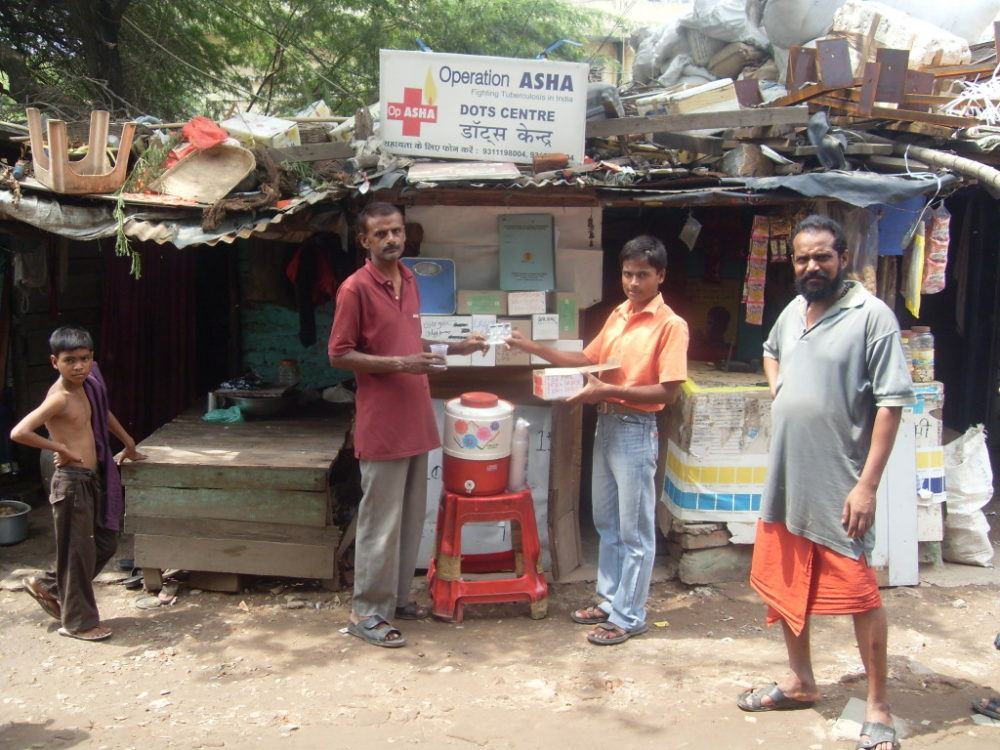
Operation Asha: dramatic results in TB treatment
Approximately 25% of cases of tuberculosis (TB) in the world is found in India and the disease is particularly prevalent in the poorest sectors of the country. OpASHA has taken TB treatment to the doorsteps of 4.5 million living in disadvantaged areas, in over 1,500 villages and slums spread across India and Cambodia. OpASHA’s treatment centres are established within the community so patients can procure the medicine conveniently, without wasting time or spending money on transport, or losing wages. Since OpASHA opened its first DOTS treatment centre in 2006, over 10,000 TB patients in disadvantaged areas in India and Cambodia have been treated.
Impact
Since OpASHA opened its first DOTS treatment centre in 2006, over 10,000 TB patients in disadvantaged areas in India and Cambodia have been treated. Since each untreated TB victim infects 10-15 people, OpASHA has indirectly prevented over 120,000 new tuberculosis cases in India.
Beneficiaries
OpASHA’s beneficiaries are essentially persons belonging to the Base of the Pyramid – earning $1/day or even less. Their huts are invariably made of used materials including paper boxes. There are no toilets. Water is rancid and the food is cooked next to trash covered in flies.
Sustainability
OpASHA’s impact on the community is long lasting. Our counselors create a permanent effect towards eliminating the stigma of TB by raising awareness in the community. Furthermore, treating one patient prevents the infection from spreading to 10-15 people; ensuring the completion of the treatment regimen prevents deadly drug resistance from occurring. Thus, OpASHA provides long-term sustainable health benefits.
A partnership with local and national governments has rendered OpASHA’s model financially sustainable. The local health department provides free medication, diagnostic facilities, and physicians’ services to TB patients. The District TB Administration provides office stationary and stock registers. OpASHA’s costs are only the rent for DOTS clinic and the Counselors who interact with patients.
After one of OpASHA’s treatment centers has been operating for two years, the Government of India provides a grant based on the number of successfully treated patients. To make our model sustainable, we fund the first two years of a centre, and then use the grant to maintain the centre in the subsequent years. 40 different DOTS centers that were started have become self sustainable.
Innovation
OpASHA’s innovative elements include:
- Close co-ordination with the local public health department who provide free medication, diagnostic facilities, and physicians
- Dense network of health centres open at convenient hours, so no patient has to walk further than 1km
- Trusted community leaders own the centre sites
- Local people are the counselors and therefore have a good rapport with the community
- Intensive training of staff and performance-based-salaries
- Biometric devices, developed in collaboration with the Research Department of Microsoft track patient compliance and staff movement
- An Electronic Medical Record System maintains data and generates reports. This eliminates human error and improves productivity, thus reducing costs
- A low-cost operating model
Scalability
Operation ASHA’s model is designed to operate like a franchise system to encourage easy scaling and replication. Other NGOs and for-profit companies fighting Tuberculosis open up their own clinics, which can only be sustainably established in areas with high population density. Operation ASHA avoids these start-up costs by using the homes, businesses, and temples of the poor. Since the model works from the bottom-up, it can be replicated in any zone, and by any non-profit organization. Different ecological zones and social structures can be adapted to by the local counselors.
In a report presented to the Special Session of the UN General Assembly, Operation ASHA’s model was compared to BRAC’s scalable TB model. OpASHA forgoes the rigidity of a top-down model and allows the local community to uniquely define its operations. It is the solution that world health leaders everywhere have been looking for – a cost effective way to address disease while creating jobs for the disadvantaged at the same time.
Source of funding
A partnership with local and national governments has rendered OpASHA’s model financially sustainable. The local health department provides free medication, diagnostic facilities, and physicians’ services to TB patients. The District TB Administration provides office stationary and stock registers for inventory management. OpASHA’s costs are only the rent for DOTS clinic and the Counselors who interact with patients.
After one of OpASHA’s treatment centers has been operating for two years, the Government of India provides a grant based on the number of successfully treated patients. To make our model sustainable, we fund the first two years of a centre, and then use the grant to maintain the centre in the subsequent years. Already, 40 different DOTS centers that were started over two years ago are completely self-sustaining. Thus, OpASHA only needs external funding for the initial one-time expense of running the program for the first two years before the grant pays for the program.